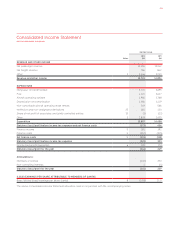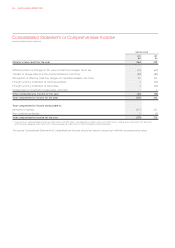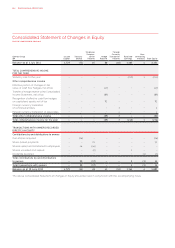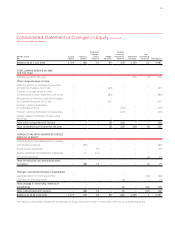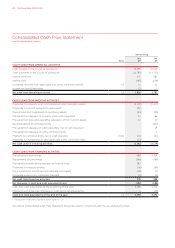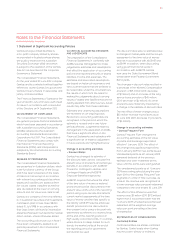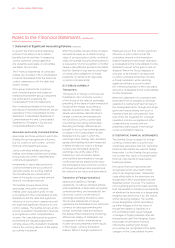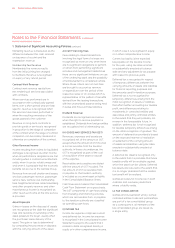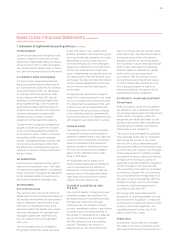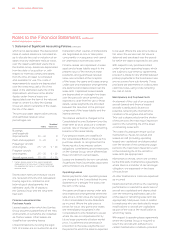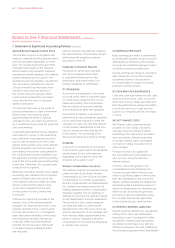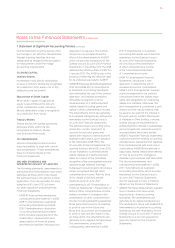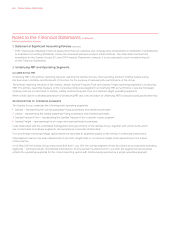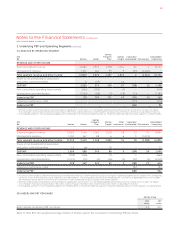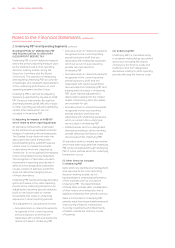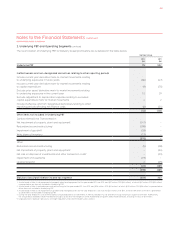Qantas 2012 Annual Report Download - page 75
Download and view the complete annual report
Please find page 75 of the 2012 Qantas annual report below. You can navigate through the pages in the report by either clicking on the pages listed below, or by using the keyword search tool below to find specific information within the annual report.
FOR THE YEAR ENDED 30 JUNE 2012
Notes to the Financial Statements continued
Statement as the underlying hedged
item. Changes in underlying market
conditions or hedging strategies could
result in recognition in the Consolidated
Income Statement of changes in fair
value of derivative financial instruments
designated as hedges.
At the inception of the transactions, the
Qantas Group documents the relationship
between hedging instruments and hedged
items, including the risk management
objective and strategy for undertaking
each transaction. The Qantas Group also
documents its assessment, both at hedge
inception and on an ongoing basis, of
whether the hedging instruments that are
used in hedge transactions have been
and will continue to be highly effective.
Fair Value Hedges
Changes in the fair value of derivative
financial instruments that are designated
and qualify as fair value hedges are
recorded in the Consolidated Income
Statement, together with any changes
in the fair value of the hedged asset
or liability that are attributable to the
hedged risk.
Cash Flow Hedges
The effective portion of changes in the
fair value of derivative financial instruments
that are designated and qualify as cash
flow hedges are recognised in other
comprehensive income and are presented
within equity in the hedge reserve. The
cumulative gain or loss in the hedge reserve
is recognised in the Consolidated Income
Statement in the periods when the hedged
item will affect profit or loss (i.e. when
the underlying income or expense is
recognised). Where the hedged item is
of a capital nature, the cumulative gain
or loss recognised in the hedge reserve
is transferred to the carrying amount of
the asset or liability when the asset or
liability is recognised.
When a hedging instrument expires or
is sold, terminated or exercised, or the
Qantas Group revokes designation of
the hedge relationship but the hedged
forecast transaction is still expected to
occur, the cumulative gain or loss at that
point remains in the hedge reserve and
is recognised in accordance with the
above policy when the transaction occurs.
If the underlying hedged transaction
is no longer expected to take place,
the cumulative unrealised gain or loss
recognised in the hedge reserve with
respect to the hedging instrument is
recognised immediately in the Consolidated
Income Statement.
Ineffective and Non-designated
Derivatives
From time to time certain derivative
financial instruments do not qualify for
hedge accounting notwithstanding that
the derivatives are held to hedge identified
exposures. Any changes in the fair value
of a derivative instrument, or part of a
derivative instrument, that do not qualify
for hedge accounting are classified as
“ineffective” and recognised immediately
in the Consolidated Income Statement.
Fair Value Calculations
The fair value of financial instruments
traded in active markets is based on
quoted market prices at balance date.
The fair value of financial instruments
that are not traded in an active market
are estimated using valuation techniques
consistent with accepted market practice.
The Qantas Group uses a variety of
methods and input assumptions that
are based on market conditions existing
at balance date.
Financial Guarantee Contracts
Financial guarantee contracts are
recognised as a financial liability at
the time the guarantee is issued. The
liability is initially measured at fair value
and subsequently at the higher of the
amount determined in accordance with
AASB 137 Provisions, Contingent Liabilities
and Contingent Assets and the amount
initially recognised less cumulative
amortisation, where appropriate.
The fair value of financial guarantees
is determined as the present value of
the difference in net cash flows between
the contractual payments under the debt
instrument and the payments that would
be required without the guarantee, or the
estimated amount that would be payable
to a third party for assuming the obligations.
Where guarantees in relation to loans
or payables of associates and jointly
controlled entities are provided for
no compensation, the fair values
are accounted for as contributions
and recognised as part of the cost
of the investment.
G REVENUE RECOGNITION
Passenger, Freight and Tours
and Travel Revenue
Passenger and freight revenue is measured
at the fair value of the consideration
received, net of sales discount, passenger
and freight interline/IATA commission
and Goods and Services Tax. Other sales
commissions paid by the Qantas Group
are included in expenditure. Tours and
travel revenue is measured at the net
amount of commission retained by the
Qantas Group.
Passenger, freight and tours and travel
revenue is recognised when passengers
or freight are uplifted or when tours and
travel air tickets and land content are
utilised. Unused tickets are recognised
as revenue using estimates based on
the terms and conditions of the ticket.
Passenger recoveries (including fuel
surcharge on passenger tickets) are
included in net passenger revenue.
Freight fuel surcharge is included in
net freight revenue.
Frequent Flyer Revenue
Redemption Revenue
Revenue received for the issuance
of points is deferred as a liability
(revenue received in advance) until
the points are redeemed or the
passenger is uplifted, in the case
of Qantas Group flight redemptions.
Redemption revenue is measured based
on management’s estimate of the fair
value of the expected awards for which
the points will be redeemed. The fair
value of the awards is reduced to take
into account the proportion of points
that are expected to expire (breakage).
Marketing Revenue
Marketing revenue associated with
the issuance of points is recognised
when the service is performed
(typically on the issuance of the point).
1. Statement of Significant Accounting Policies continued
073




